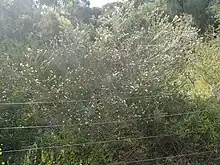| Esperance wax | |
|---|---|
 | |
| Scientific classification | |
| Kingdom: | Plantae |
| Clade: | Tracheophytes |
| Clade: | Angiosperms |
| Clade: | Eudicots |
| Clade: | Rosids |
| Order: | Myrtales |
| Family: | Myrtaceae |
| Genus: | Chamelaucium |
| Species: | C. axillare |
| Binomial name | |
| Chamelaucium axillare | |
| Synonyms[1] | |
| |

Chamelaucium axillare, commonly known as Esperance waxflower,[2] is a species of flowering plant in the family Myrtaceae endemic to Western Australia.
The erect shrub typically grows to a height of 0.2 to 2 metres (1 to 7 ft). It blooms between September and December producing white-pink-red flowers.[2]
Often grown as an ornamental shrub it has scented evergreen foliage produces red buds and small white flowers. It can be grown as a light screen and used for cut flowers.[3]
Found along the south coast with a scattered distribution in the Goldfields-Esperance region of Western Australia where it grows in sandy soils.[2]
The species was originally described by the botanist George Bentham in 1867 Flora Australiensis.[4][5] In 1882, Ferdinand von Mueller changed the name to Darwinia axillaris in his Systematic Census of Australian Plants, but the name has not been accepted by other authorities.[6][7]
References
- 1 2 "Chamelaucium axillare". Australian Plant Census. Retrieved 1 October 2022.
- 1 2 3 "Chamelaucium axillare". FloraBase. Western Australian Government Department of Biodiversity, Conservation and Attractions.
- ↑ "Chamelaucium axillare". Australian Native Plants. Retrieved 1 March 2017.
- ↑ "Chamelaucium axillare". APNI. Retrieved 1 October 2022.
- ↑ Bentham, George; von Mueller, Ferdinand (1867). Flora Australiensis. Vol. 3. London: Lovell Reeve & Co. I. pp. 38–39. Retrieved 1 October 2022.
- ↑ "Darwinia axillaris". APNI. Retrieved 1 October 2022.
- ↑ von Mueller, Ferdinand (1882). Systematic Census of Australian Plants. Melbourne: Victorian Government Printer. p. 51. Retrieved 1 October 2022.